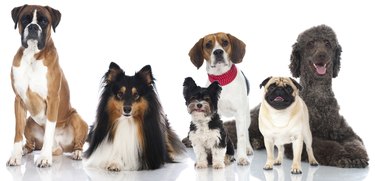
You might not think too much about your new dog's ancestry when you adopt her from the shelter as it's likely your bond was love at first sight. But as you and your dog become more familiar with one another, the way she cocks those oversized bat ears or obsession with digging up gophers in the yard is sure to get you wondering. Breed labels assigned by shelter staff or other professionals aren't always accurate, according to the National Canine Research Council, but careful observation of your dog over time can offer important clues to parentage.
Check out her figure
Video of the Day
If your dog is older than a year, check out characteristics in her build. Make note of her weight, and whether her body is thick or slender. When you see her from the side, is the length of her body from shoulder to rump roughly the same length of her legs (boxy), or is her torso longer? Write down any attributes such as whether she has a deep chest, is particularly dense in weight for her size, sports chiseled muscles or a sleek, athletic build. Dogs with long tails are common, but some breeds like French bulldogs and the Brittany have naturally short tails.
Video of the Day
A dog's body shape reflects the type of work its ancestors were bred to perform. A wiry and supple build might reflect terrier breeds that were used to pursue small prey both above ground and into a den. Breeds used for retrieving prey from the water such as retrievers and poodles are light-boned and often have webbed feet. Stocky, heavily built dogs like Rottweilers hail from the working dog group that was used to guard livestock, pull carts and performs other day-to-day tasks in a rural setting. Dogs with long legs and slender bodies usually come from the sighthound breeds used to pursue prey, such as greyhounds and Salukis.
Cuddle up with that coat
Looking at your dog's coat markings can tell you a lot about his parentage. For example, a golden coat might indicate a yellow Lab or golden retriever in the dog's gene pool, where a black or tuxedo pattern could indicate a black Labrador retriever.
The texture is important, too. Coat types range from smooth with no undercoat to wiry, curly, corded, heavy, and double- coated, among others. Some dogs have silky coats that are closer in texture to human hair than fur. Ask your dog groomer what type of coat your dog has if you're not certain or consult a dog breed identification chart.
When she's all ears
Although dog ears generally fall into those that stand up, fold over or hang down, ear shape offers valuable information of your dog's breed mix. Dogs with basic prick ears that stand up in a triangle shape are often influenced by breeds such as German shepherds, husky, or other Nordic breeds. If tips are blunt, rounded, hooded, or shaped like candle flames, these traits could be inherited from breeds such as French bulldogs, corgis, Basenjis or English toy terriers. The same holds true for dogs with fold-over ears and hanging ears. A basset hound's ears hang straight down like a pendant, but a bloodhound's ears hang down with draped folds. A Jack Russel terrier has ears that fold in half, called button ears, while a dog influenced by collie ancestry might have the tips of the ears cocked forward.
Keep in mind that some dog breeds like pit bulls and Great Danes sometimes have their ears cropped. Both breeds have ears that naturally fold over, with Great Dane ears sometimes appearing as short hanging ears. Once you know your dog's ear type, a dog breed identification chart can help you identify breeds with similar ears.
Behavior offers clue
Does your dog have some quirky behaviors? It might offer a hint that can help you analyze your dog's appearance. Every breed of dog has been refined over the years for specific behavioral traits according to the ASPCA. Blue heelers, for example, sometimes "herd" people or other pets. A dog who gets excited about swimming or playing fetch could have a Labrador retriever or other water-dog breed as an ancestor. A feisty dog with lots of energy could potentially hail from the terrier group and a dog who spends the night serenading the neighborhood with a mournful howl is likely from the hound group. Go on the ASPCA's Dog Breeds page on their website, and you can enter traits your dog has, such as activity level, size, coat type, and other characteristics that can help you narrow down your dog's heritage.
Beyond a dog breed identification chart
Search the internet for dog breeds that have your dog's most notable features. For example, a search for "black + curly coat + webbed feet" brings up images of curly-coated retrievers, Portuguese water dogs, poodles, and American water spaniels. You can then compare your dog's body shape, ears, and other features to the photos.